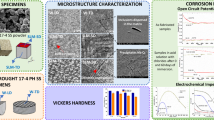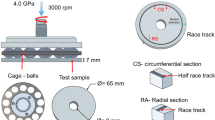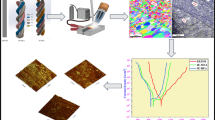Abstract
The corrosion and corrosion-fatigue behaviors of INCONEL 625 weld metal surfaced onto 3.25 pct nickel steel using the gas metal arc welding-pulsed arc process are presented. General, crevice, and bent-beam stress corrosion studies were performed. Completely reversed bending corrosion-fatigue and corrosion fatigue crack growth behaviors were also evaluated. The sea water corrosion resistance of the surface weld metal was equivalent to wrought base metal at levels of iron up to 9 pct, provided the molybdenum concentration was greater than 8 pct. Stress relief heat treatment did not degrade corrosion resistance properties. The corrosion fatigue strength of the surface weld metal at 108 cycles was found to be 103.4 MPa (15 ksi) which is lower than values reported for multiple pass INCONEL 625 welds, but is significantly higher than the corrosion fatigue strength of 3.25 nickel steel. Fatigue crack growth rates for the surface weld metal were found to be higher than the wrought INCONEL 625 base metal and the steel. Stress relief heat treatment does not alter corrosion fatigue crack growth rates of the clad 1N-625 surface weld metal.
Similar content being viewed by others
References
F. W. Fink and W. K. Boyd:The Corrosion of Metals in Marine Environments, Bayer and Company, Inc., Columbus, OH, 1970, pp. 32–40.
R.G. Gilliland and G.M. Slaughter:Welding Journal, Research Suppl., July 1966, vol. 45 (7), pp. 314–S-320–S.
H. R. Conaway and J. H. Mesick:Welding Journal, Research Suppl., Jan. 1970, pp. 27-s–32-s.
D. F. Hasson, C. Zanis, L. Aprigliano, and C. Fraser:Welding Journal, Research Suppl., Jan. 1978, vol. 56 (1), pp. 1–s-8–s.
C. E. Jaske, J. H. Payer, and V. S. Balint:Corrosion Fatigue of Materials in Marine Environments, Springer-Verlag, New York, NY-Heidelberg-Berlin, 1981, p. 72.
Anon.,Inconel Alloy 625, Huntington Products Division, The International Nickel Company, Inc., Huntington, WV, 1970.
T. A. Long, Jr.: “Comparison of Fatigue Crack Propagation in Inconel 625 and 3.25 Nickel Steel,” Masters Thesis, M.I.T., June 1972.
“Electrode and Rods —Welding, Bare, Nickel Alloy,” Mil Spec MIL-E-21562D, May 25, 1972.
Nickel-Chromium-Molybdenum-Columbium Alloy Plate, Sheet and Strip, ASTM B433-66, 1974.
“Mechanical Tests for Welded Joints,” Military Standard, MIL-STD-00418C, June 15, 1972.
Tension Testing of Metallic Materials, ASTM E-8, Phila., PA, 1974.
J. Kruger and J. R. Ambrose: National Bureau of Standards, IR76-1170, Nov. 1976.
G.R. Yoder, L. A. Cooley, and T.W. Crooker: ASTM STP 801, ASTM, 1983, pp. 159–174.
T. W. Crooker, D. F. Hasson, and G. R. Yoder: ASTM STP 600, ASTM, 1976, pp. 205–219.
A.N. Babaev and A. E. Vainerman:Avt. Svarka, 1976, no. 2, pp. 35–37.
L.L. Shoak, Jr. and C.L. Long:SNAME, 1957, pp. 682–702.
Author information
Authors and Affiliations
Rights and permissions
About this article
Cite this article
Hasson, D.F., Zanis, C., Aprigliano, L. et al. Corrosion and corrosion-fatigue behavior of IN625 Weld Surfaced 3.25 Nickel Steel. JMES 7, 256–264 (1985). https://doi.org/10.1007/BF02833389
Issue Date:
DOI: https://doi.org/10.1007/BF02833389




